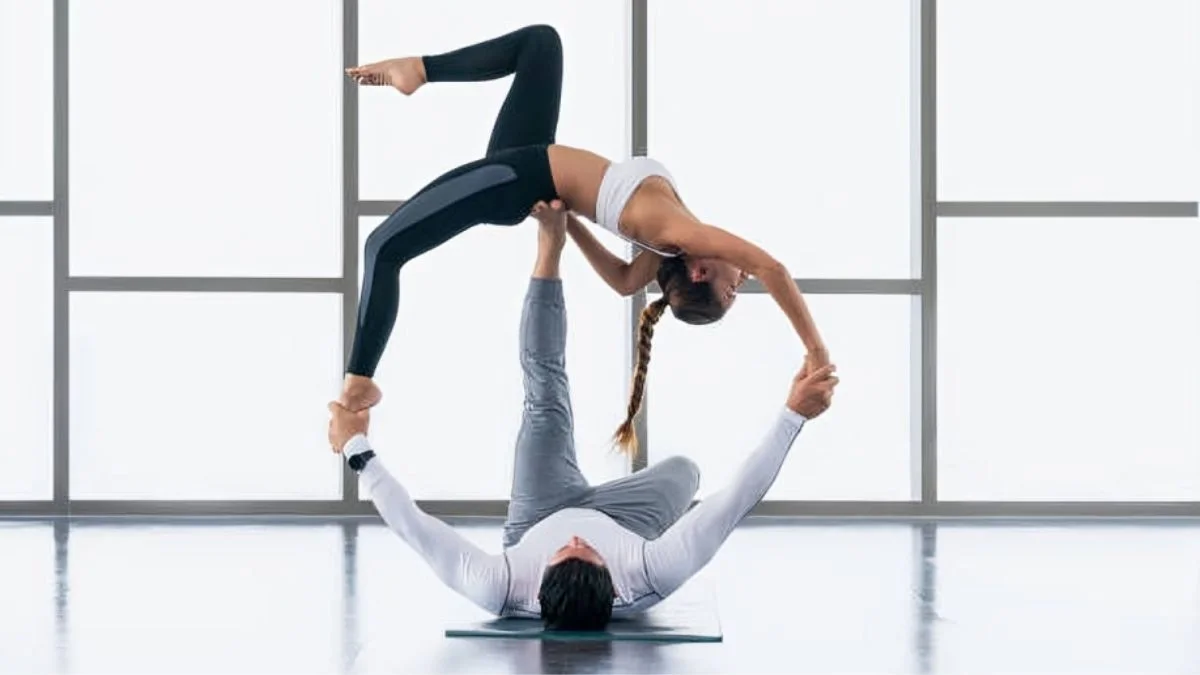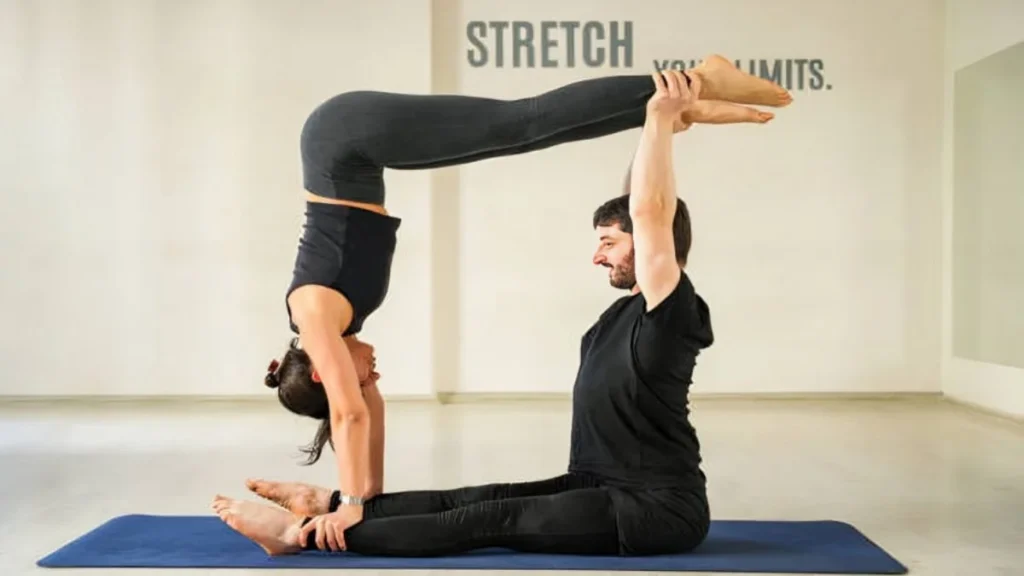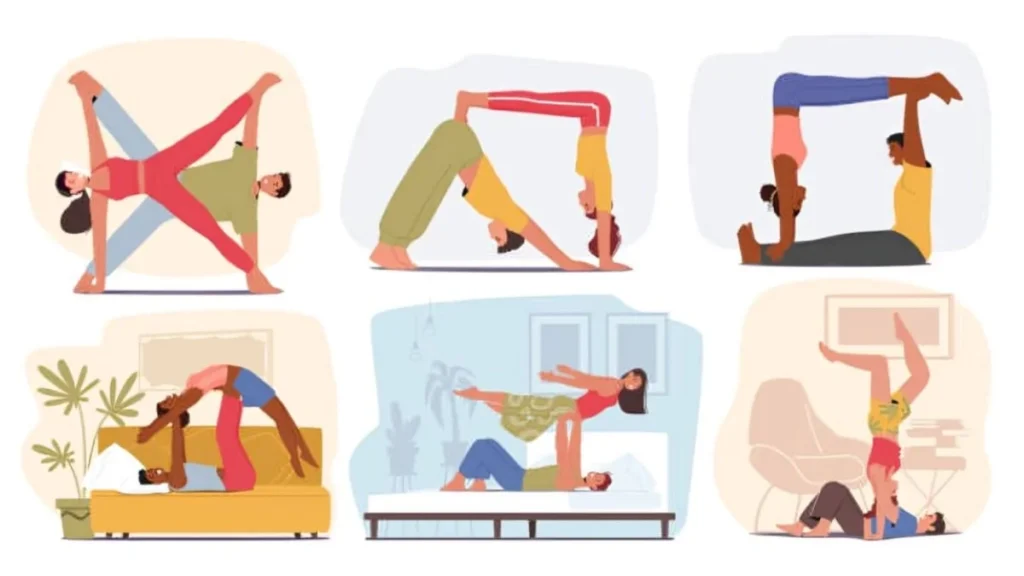YOGA
What is Acroyoga? A Beginner’s Guide to Yoga, Acrobatics, and Partner Lifts

Introduction
Acroyoga is a physically demanding discipline that blends aspects of yoga, acrobatics, and therapeutic arts. It entails pairs cooperating to carry out a range of acrobatic lifts, balances and stretches. It is possible to write “Acroyoga” or “Acro-Yoga” depending on your preferred style. Whatever the spelling, the practice’s core is still the same: a symphony of yoga, acrobatics, and connection, with roots in both classical acrobatics and ancient yoga, acro yoga dates back to the early 2000s. The discipline gained popularity thanks to its founders, Jenny Sauer-Klein and Jason Nemer, who combined the exhilaration of acrobatics with the mindfulness of yoga.
Table of Contents
Fundamentals of Acroyoga
Acroyoga practitioners can maximize their experience by adhering to certain fundamental principles:
Yoga and Acrobatics together
Acroyoga promotes both physical and mental development by fusing the calming energy of yoga with the strenuous physical demands of acrobatics.
The Function of Group and Partner Acrobatics
Acroyoga is a group activity. Lifting and balancing properly requires trust and communication, whether one is operating in a group or pairs.
Combining Dance, Cheerleading, and Circus Arts
The combination of cheerleading, dancing, and circus arts gives the exercise a performance component that turns it from a workout into an artistic outlet.
Kinds of Partner Acrobatics Practices in Acroyoga
Partner acrobatics involves two people cooperating to execute a variety of lifts and positions. Both partners use their core muscles and balance while one (the base) supports the other (the flyer).
Collective Acrobatics
Group acrobatics features numerous people collaborating on more complex lifts and structures. It calls for even greater cooperation, trust, and communication among participants.
Acroyoga for therapeutic purposes
The goals of therapeutic acro yoga include healing and relaxation. The base eases the flyer’s stress and encourages relaxation by slowly moving and stretching them.

Standing vs. L-Basing Acro
L-basing calls for the base to be on the ground, supporting the flyer with their hands and feet, whereas standing acro calls for lifts and balances from both players standing.
The Physical Advantages of Acroyoga: Stability, Flexibility, and Strength
Acro yoga increases flexibility, balance, and strength, especially in the arms, legs, and core. Tone and endurance of muscles are improved by repeatedly lifting and holding poses.
Benefits for the Mind: Developing Confidence, Trust, and Communication
It is a physical and mental strengthening practice. Encouraging communication and trust between partners helps people feel secure and confident in their capacity to rely on others.
Social Benefits: Partner connections and community involvement
Acro yoga fosters stronger connections between people and is a very social activity. When done with friends, partners, or complete strangers, it strengthens the bonds of community and encourages cooperation.
Poses and Acroyoga Moves
Simple Poses
- Bird: The flyer uses the base’s feet to maintain a horizontal equilibrium.
- Throne: The flyer is erect on the feet of the base.
- Front Plank: This is a basic balancing in which the flyer is held in a plank posture.
Poses in Intermediate
- Star: The flyer forms the shape of a star by balancing on one of the base’s hands.
- Shoulder Stand: While inverted, the flyer maintains balance on the feet of the base.
- Side Star: An energetic variation of the star stance that calls for even more equilibrium.

How to Start an AcroYoga Practice
Finding Acro Yoga Workshops and Classes
Find local courses or lessons to begin practicing acro yoga. These days, acro yoga sessions are offered for all skill levels in many studios and fitness centers.
What to expect from your first acro yoga lesson
You can anticipate participating in partner exercises, learning basic lifts, and practicing techniques for developing trust and communication in your first Acroyoga class. In general, the atmosphere is supportive and focused on the community.
- Foot-to-Hand: The flyer must balance on the hands of the base during this technique, which requires tremendous strength and balance.
- Hand-to-Hand: For balance, both people rely on their hands.
- Reverse Star: The flyer balances on the base’s hands while inverted.
Acroyoga Safety Advice and Best Practices
- Spotter’s importance
A spotter assists in directing motion and averting falls to guarantee safety.
- Appropriate Methods to Prevent Damage
Always warm up, speak with your partner, and go carefully through moves.
- Keeping Lines of Communication Open and Safe with Partners
For acro yoga to be both successful and safe, clear communication is essential. Throughout, make sure you and your partner agree.
11. Conclusion
The popularity of acroyoga is still rising, and more people are becoming practitioners every day. Its blend of yoga, acrobatics, and teamwork makes it an extremely gratifying and captivating exercise. It is a discipline that promotes community, trust, and connection rather than merely being a fad in fitness. It is a long-lasting component of contemporary wellness culture because of its holistic approach to social, mental, and physical well-being. To become an expert in Acroyoga, prioritize trust, communication, and consistency. The trip is just as fulfilling as the destination, regardless of experience level.
-

 GENERAL6 months ago
GENERAL6 months agoChristofle – For Those Who Dream of Family Heirloom Silver
-

 SPORTS8 months ago
SPORTS8 months agoDiscover the World of Football with Streameast: Watch Your Favorite Leagues and Tournaments
-

 GENERAL4 months ago
GENERAL4 months agoUncovering the World of кинокрадко: The Dark Side of Film Piracy
-

 GENERAL2 months ago
GENERAL2 months agoATFBooru: Anime, Gaming, and Subculture Imageboard























